Reducing the Carbon Footprint of the Water-Energy Binomial through Governance and ICT. A Case Study
Abstract
1. Introduction
2. Materials and Methods
2.1. Field Data
2.1.1. Agroclimatic Characteristics
2.1.2. Available Resources and Water Demand
2.2. Equivalent CO2 eq Flow to the Atmosphere
2.3. Adopted Measures for Reduction of the Carbon Footprint
2.3.1. Minimization of the Energy
2.3.2. Analysis of the Available Technologies
- Wind energy: after examination and according to the wind maps, the main conclusion was that insufficient available power. It would be necessary to complement the same with other alternative and safe energy sources, in order to avoid periods without energy supply.
- Water energy: the irrigation network design takes advantage of the existent overpressures at several points of the system in order to generate electric energy. After a technical study, the incorporation of this technology was evaluated. The solution was the incorporation of two micro turbines linked to the existing pressure reduction valves. Moreover, the installed powers were 10 and 7.5 kW. This option was discarded because of the low power available. Additionally, the large distance between energy generation and the nearest consumption (nearly three kms distance to the filtering system) can generate major losses due to the energy used during transportation.
2.4. Solar Photovoltaic System
2.5. Water Footprint
2.5.1. Direct Consumption Reduction by Governance
2.5.2. Indirect Consumption Reduction (ICR)
- ICR by evaporation potential: losses due to evaporation on the surface of the ponds during storage (these represents the losses associated with the insulation received by the water sheet surfaces of the ponds and whose value has been estimated at 0.5 m3/m2) [43]. To estimate this, the initial losses must first be evaluated with the rafts that are available before applying the reductive actions. After applying these actions, the new exposed surfaces are calculated. The rafts and two others have been covered with a TPO polypropylene sheet reinforced with polyester mesh inside, which is estimated to be reduced by 95%. With the difference in volume of evaporated water WeBA = 53,514 m3 before and after the corrective actions WeAA = 27,492 m3, the water footprint that is generated has been quantified, obtaining a value of WeR = 26,022 m3 representing the volume of water annually saved by covering rafts and the reduction of surface exposed to insolation, by eliminating two of the rafts and transforming these into photovoltaic plants (Table 4).
- ICR for water improvements: The new improvement introduced in the system as the doubling of the pipes enabled a more adequate exploitation and the distribution in open ducts has been eliminated in front of pressurized pipes while remote control systems with controlled solenoid valves have been installed. Solenoids and counters in the irrigation head enable a balance of water inlets and outlets which helps clarify which sectors and networks suffer from water loss and require repair. This type of improvement reduces the total volume of losses (Vls = 946,651.90 m3) by approximately 30%, which in turn reduces the water footprint for water improvements of the system (VlsR = 283,995.57 m3). Finally, the value of the reduction of the water footprint is based on the reduction by direct consumption (by governance and ICT) and indirect consumption (by evaporation and by hydraulic actions) (Figure 9), equaling a total amount of 731,014.41 m3, disaggregated according to the summary displayed in Table 5.
3. Results
3.1. Reduction of Carbon Footprint by Water Footprint
3.2. Sequestration of CO2 eq by Crops
3.3. Total CO2 eq Balance of Our W-E SYSTEM in a WUA
- 111.18 t CO2 eq for the TST pumping.
- 167.31 t CO2 eq for pumping Well.
- 33.46 t CO2 eq for pumping WWTP.
4. Discussion
5. Conclusions
- reduction of at least 40% of greenhouse gas emissions (relative to 1990 levels).
- increase of at least 27% in the share of renewable energies.
- improve energy efficiency by at least 27%.
- ▪
- SDG 6 (sections 6.3 and 6a), the use of reclaimed water using alternative energies and ICTs is promoted, as well as actions to cover reservoirs that produce a better efficient use of the water resources of this WUA.
- ▪
- SDG 7 (sections 7.2 and 7.3), the increase in the proportion of renewable energy in our system is evidenced).
- ▪
- SDG 12 (sections 12.2 and 12.4), the set of actions described produces sustainable management and an improvement in the efficient use of natural resources, in our case water. All the actions described in this paper are aimed at reducing emissions to the atmosphere.
- ▪
- SDG 15 (section 15.3), the lands included in this study and during its preparation (last 4 years) have been affected, by periods of drought and floods, which, if it were not for the aid articulated by the European Union, would be led to abandonment and subsequent desertification.
Author Contributions
Funding
Acknowledgments
Conflicts of Interest
References
- Murcia and Water: History of a Passion. Regional Assembly of Murcia (Spain) (In Spanish). Available online: https://www.asambleamurcia.es/divulgacion/murcia-y-el-agua-historia-de-una-pasion (accessed on 5 November 2020).
- Caro Baroja, J. The Villages of Spain; Ediciones Istmo: Madrid, Spain, 2003; Volume 3011. (In Spanish) [Google Scholar]
- Vera, J.F.; Olcina, J.; Hernández, M. Landscape, Territorial Culture and Experience of Geography. Book Tribute to Professor Alfredo Morales Gil; Publications of the University of Alicante: San Vicente del Raspeig, Alicante, Spain, 2016. [Google Scholar]
- Melgarejo, J.; López-Ortiz, M.I. Wastewater Treatment and Water Reuse in Spain. Water Landsc. 2016. (In Spanish) [Google Scholar] [CrossRef]
- Dingkuhn, M.; Luquet, D.; Fabre, D.; Muller, B.; Yin, X.; Paul, M.J. The case for improving crop carbon sink strength or plasticity for a CO2-rich future. Curr. Opin. Plant Biol. 2020. [Google Scholar] [CrossRef] [PubMed]
- Nowak, D.J.; Greenfield, E.J.; Hoehn, R.E.; Lapoint, E. Carbon storage and sequestration by trees in urban and community areas of the United States. Environ. Pollut. 2013, 178, 229–236. [Google Scholar] [CrossRef] [PubMed]
- Vanuytrecht, E.; Raes, D.; Willems, P. Considering sink strength to model crop production under elevated atmospheric CO2. Agric. For. Meteorol. 2011, 151, 1753–1762. [Google Scholar] [CrossRef]
- Daum, T. ICT Applications in Agriculture. In Reference Module in Food Science. Encyclopedia of Food Security and Sustainability; Elsevier: Amsterdam, The Netherlands, 2019; Volume 1, pp. 255–260. [Google Scholar]
- Ferrández-Villena, M.; Ruiz-Canales, A. Advances on ICTs for water management in agriculture. Agric. Water Manag. 2017, 183, 1–3. [Google Scholar] [CrossRef]
- Sahu, B.; Chatterjee, S.; Mukherjee, S.; Sharma, C. Tools of precision agriculture: A review. Int. J. Chem. Stud. 2019, 7, 2692–2696. [Google Scholar]
- Camacho, E.; Rodríguez, J.; Montesinos, P. Saving water and energy consumption in the modernisation of irrigation (In Spanish). In Effects of the Modernisation of Irrigation in Spain; Berbel, J., Gutiérrez-Martín, C., Eds.; Cajamar: Almería, Spain, 2017; pp. 221–249. [Google Scholar]
- Fernández-Pacheco, D.; Ferrández-Villena, M.; Molina-Martínez, J.; Ruiz-Canales, A. Performance indicators to assess the implementation of automation in water user associations: A case study in southeast Spain. Agric. Water Manag. 2015, 151, 87–92. [Google Scholar] [CrossRef]
- Melián-Navarro, A.; Molina-Martínez, J.; Rodríguez-Díaz, J.; Ruiz-Canales, A. Performance indicators to assess the implementation of automation in golf courses located in Southeast Spain. Agric. Water Manag. 2017, 183, 35–40. [Google Scholar] [CrossRef]
- Daccache, A.; Ciurana, J.; Diaz, J.R.; Knox, J.W. Water and energy footprint of irrigated agriculture in the Mediterranean region. Environ. Res. Lett. 2014, 9, 124014. [Google Scholar] [CrossRef]
- Jackson, T.M.; Khan, S.; Hafeez, M. A comparative analysis of water application and energy consumption at the irrigated field level. Agric. Water Manag. 2010, 97, 1477–1485. [Google Scholar] [CrossRef]
- Jiménez Beltrán, D. New Trends in Wastewater Treatment and Use. City and Territory Territorial Studies (CyTET) (In Spanish). 1981. Available online: https://recyt.fecyt.es/index.php/CyTET/article/view/81581 (accessed on 12 July 2020).
- Grigoriev, A.; Sinyak, Y.E.; Samsonov, N.; Bobe, L.; Protasov, N.; Andreychuk, P. Regeneration of water at space stations. Acta Astronaut. 2011, 68, 1567–1573. [Google Scholar] [CrossRef]
- Nicolau, E.; Fonseca, J.J.; Rodríguez-Martínez, J.A.; Richardson, T.-M.J.; Flynn, M.; Griebenow, K.; Cabrera, C.R. Evaluation of a urea bioelectrochemical system for wastewater treatment processes. ACS Sustain. Chem. Eng. 2014, 2, 749–754. [Google Scholar] [CrossRef]
- Pickett, M.T.; Roberson, L.B.; Calabria, J.L.; Bullard, T.J.; Turner, G.; Yeh, D.H. Regenerative water purification for space applications: Needs, challenges, and technologies towards ‘closing the loop’. Life Sci. Space Res. 2020, 24, 64–82. [Google Scholar] [CrossRef] [PubMed]
- Rothausen, S.G.; Conway, D. Greenhouse-gas emissions from energy use in the water sector. Nat. Clim. Chang. 2011, 1, 210–219. [Google Scholar] [CrossRef]
- Schilardi, C. Design of a aphotovoltaic solar pumping system for drip irrigation in vineyards (In Spanish). In Proceedings of the II Congreso de Agua, Ambiente y Energía, Montevideo, Argentina, 25–27 September 2019. [Google Scholar]
- Sandoval Estrada, M.; Stolpe Lau, N.; Zagal Venegas, E.; Mardones Flores, M.; Junod Montano, J. The Carbon Sequestration in Agriculture and its Importance in Global Warming. Theoria 2003, 12, 65–71. (In Spanish) [Google Scholar]
- Sadegh, M.; AghaKouchak, A.; Mallakpour, I.; Huning, L.S.; Mazdiyasni, O.; Niknejad, M.; Foufoula-Georgiou, E.; Moore, F.C.; Brouwer, J.; Farid, A. Data and analysis toolbox for modeling the nexus of food, energy, and water. Sustain. Cities Soc. 2020, 61, 102281. [Google Scholar] [CrossRef]
- Xu, Q.; Hu, K.; Yao, Z.; Zuo, Q. Evaluation of carbon, nitrogen footprint and primary energy demand under different rice production systems. Ecol. Indic. 2020, 117, 106634. [Google Scholar] [CrossRef]
- Chazarra-Zapata, J.; Parras-Burgos, D.; Arteaga, C.; Ruiz-Canales, A.; Molina-Martínez, J.M. Adaptation of a Traditional Irrigation System of Micro-Plots to Smart Agri Development: A Case Study in Murcia (Spain). Agronomy 2020, 10, 1365. [Google Scholar] [CrossRef]
- Yan, Z.; Hou, F.; Hou, F. Energy Balances and Greenhouse Gas Emissions of Agriculture in the Shihezi Oasis of China. Atmosphere 2020, 11, 781. [Google Scholar] [CrossRef]
- Chazarra-Zapata, J.; Molina-Martínez, J.M.; Cruz, F.-J.P.D.L.; Parras-Burgos, D.; Ruíz Canales, A. How to Reduce the Carbon Footprint of an Irrigation Community in the South-East of Spain by Use of Solar Energy. Energies 2020, 13, 2848. [Google Scholar] [CrossRef]
- Cardozo, N.P.; de Oliveira Bordonal, R.; La Scala, N., Jr. Greenhouse gas emission estimate in sugarcane irrigation in Brazil: Is it possible to reduce it, and still increase crop yield? J. Clean. Prod. 2016, 112, 3988–3997. [Google Scholar] [CrossRef]
- Cheng, L.; Yue, W.; QIU, G.-Y. Water and energy consumption by agriculture in the Minqin Oasis Region. J. Integr. Agric. 2013, 12, 1330–1340. [Google Scholar] [CrossRef]
- Wang, J.; Rothausen, S.G.; Conway, D.; Zhang, L.; Xiong, W.; Holman, I.P.; Li, Y.J.E.R.L. China’s water–energy nexus: Greenhouse-Gas emissions from groundwater use for agriculture. Environ. Res. Lett. 2012, 7, 14035. [Google Scholar] [CrossRef]
- Khoshnevisan, B.; Rafiee, S.; Omid, M.; Mousazadeh, H.; Rajaeifar, M.A. Application of artificial neural networks for prediction of output energy and GHG emissions in potato production in Iran. Agric. Syst. 2014, 123, 120–127. [Google Scholar] [CrossRef]
- Pishgar-Komleh, S.H.; Omid, M.; Heidari, M.D. On the study of energy use and GHG (greenhouse gas) emissions in greenhouse cucumber production in Yazd province. Energy 2013, 59, 63–71. [Google Scholar] [CrossRef]
- Carrillo Cobo, M.; Camacho Poyato, E.; Montesinos, P.; Rodríguez Díaz, J. New model for sustainable management of pressurized irrigation networks. Application to Bembézar MD irrigation district (Spain). Sci. Total Environ. 2014, 473, 1–8. [Google Scholar] [CrossRef]
- Nugent, D.; Sovacool, B.K. Assessing the lifecycle greenhouse gas emissions from solar PV and wind energy: A critical meta-survey. Energy Policy 2014, 65, 229–244. [Google Scholar] [CrossRef]
- European Commission. Regulation of the European Parliament and of the Council Establishing the Framework for Achieving Climate Neutrality and Amending Regulation (EU) 2018/1999 (European Climate Law). Available online: https://eur-lex.europa.eu/legal-content/EN/TXT/?uri=CELEX:52020PC0080 (accessed on 2 September 2020).
- Zhang, D.D.; Pei, Q.; Lee, H.F.; Jim, C.Y.; Li, G.; Zhang, M.; Li, J.; Wu, Z.; Wang, L.; Yue, R.P. Climate change fostered cultural dynamics of human resilience in Europe in the past 2500 years. Sci. Total Environ. 2020, 744, 140842. [Google Scholar] [CrossRef]
- Šúri, M.; Huld, T.A.; Dunlop, E.D.; Ossenbrink, H.A. Potential of solar electricity generation in the European Union member states and candidate countries. Sol. Energy 2007, 81, 1295–1305. [Google Scholar] [CrossRef]
- Rosas-Flores, J.A.; Zenón-Olvera, E.; Morillón Gálvez, D.M. Potential energy saving in urban and rural households of Mexico with solar photovoltaic systems using geographical information system. Renew. Sustain. Energy Rev. 2019, 116, 109412. [Google Scholar] [CrossRef]
- Huld, T.; Müller, R.; Gambardella, A. A new solar radiation database for estimating PV performance in Europe and Africa. Sol. Energy 2012, 86, 1803–1815. [Google Scholar] [CrossRef]
- Arab, A.H.; Taghezouit, B.; Abdeladim, K.; Semaoui, S.; Razagui, A.; Gherbi, A.; Boulahchiche, S.; Mahammed, I.H. Maximum power output performance modeling of solar photovoltaic modules. Energy Rep. 2020, 6, 680–686. [Google Scholar] [CrossRef]
- Psiloglou, B.; Kambezidis, H.; Kaskaoutis, D.; Karagiannis, D.; Polo, J. Comparison between MRM simulations, CAMS and PVGIS databases with measured solar radiation components at the Methoni station, Greece. Renew. Energy 2020, 146, 1372–1391. [Google Scholar] [CrossRef]
- Order ARM/2656/2008, of 10 September, Approving the Hydrological Planning Instruction (B.O.E. No. 229, of September 22, 2008) (In Spanish). Available online: https://www.boe.es/eli/es/o/2008/09/10/arm2656 (accessed on 2 September 2020).
- Molina-Martínez, J.M.; Martínez-Álvarez, V.; Baille, A.; González-Real, M.M. Estimation of evaporation in irrigation reservoirs using an energy balance model. Ing. Agua 2006, 13, 219–230. (In Spanish) [Google Scholar] [CrossRef]
- Del Rio, M.S.; del Amor Saavedra, M.Á. Adaptation Project of Sector I “Huerta Alta” of the Pliego Irrigation Community T.M. of Pliego (Murcia). Annex No. 6 Agronomic Report (In Spanish); Government of the Region of Murcia: Murcia, Spain, 2017.
- Carvajal, M.; Mota, C.; Alcaraz-López, C.; Iglesias, M.; Martínez-Ballesta, M. Research on CO2 Absorption by the Most Representative Crops; Department, V.N., Ed.; CEBAS-Consejo Superior de Investigaciones Científicas (CSIC): Murcia, Spain, 2014. (In Spanish) [Google Scholar]
- Zermeño-González, A.; Villatoro-Moteno, S.; Cortés-Bracho, J.J.; Cadena-Zapata, M.; Catalán-Valencia, E.A.; García-Delgado, M.Á.; Munguía-López, J.P. Estimation of the net CO2 exchange in a sugar cane crop during the staffing cycle. Agrociencia 2012, 46, 579–591. (In Spanish) [Google Scholar]
- Visconti, F.; De-Paz, J.M. Estimation of the potential CO2 sequestration and emission capacity of the agricultural soils of the Valencian Community. Ecosistemas 2017, 26, 91–100. [Google Scholar] [CrossRef]
- Wang, Z.-B.; Zhang, H.-L.; Lu, X.-H.; Wang, M.; Chu, Q.-Q.; Wen, X.-Y.; Chen, F. Lowering carbon footprint of winter wheat by improving management practices in North China Plain. J. Clean. Prod. 2016, 112, 149–157. [Google Scholar] [CrossRef]
- Qureshi, A.S. Reducing carbon emissions through improved irrigation management: A case study from Pakistan. Irrig. Drain. 2014, 63, 132–138. [Google Scholar] [CrossRef]
- Macías-Vázquez, F.; Rodríguez-Lado, L. First Approximation to the Calculation of Carbon Sinks in Forestry and Soil Systems in Galicia, According to the Kyoto Protocol; Publications Service of the University of Santiago de Compostela: Santiago de Compostela, Spain, 2003. [Google Scholar]
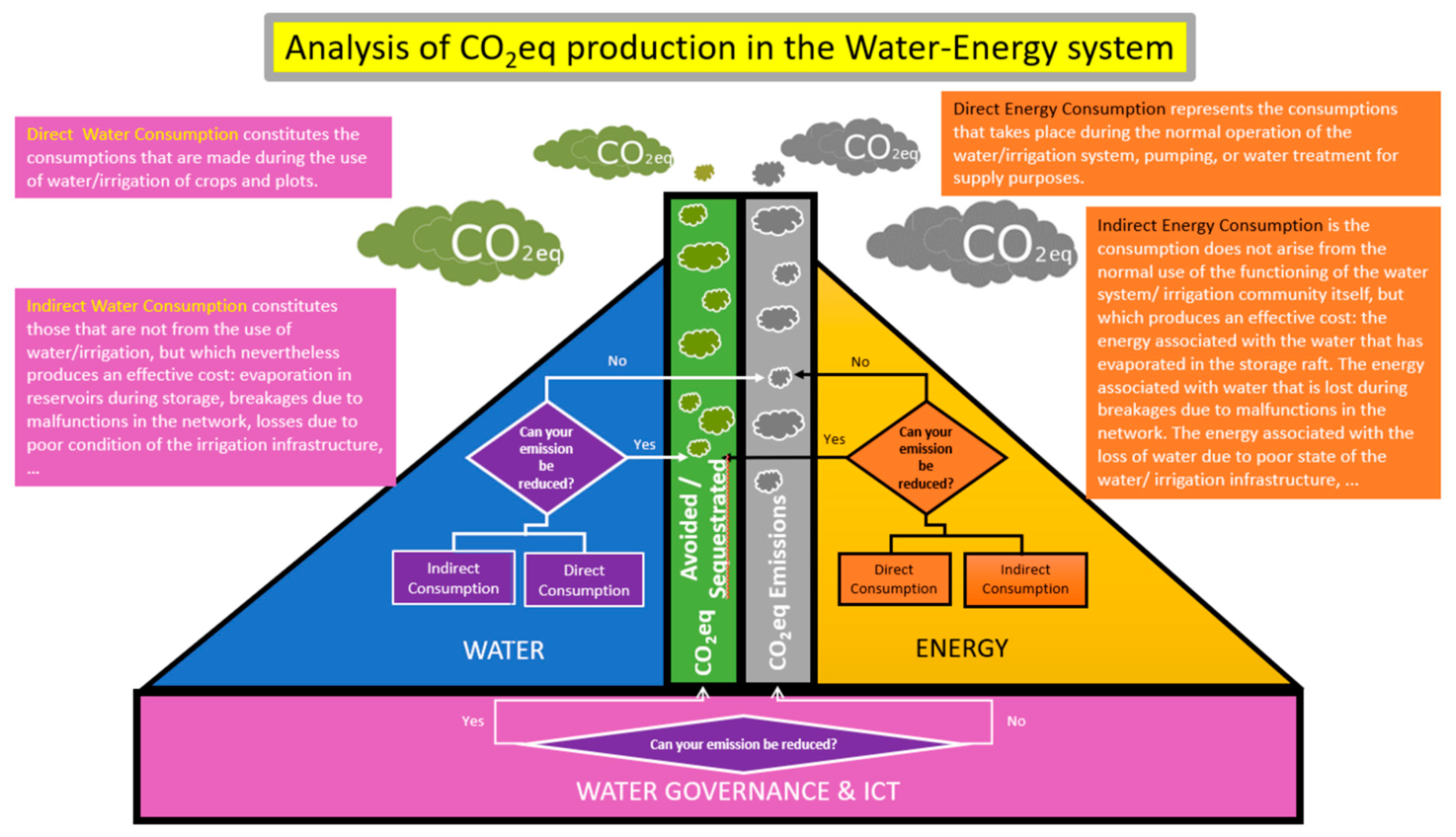
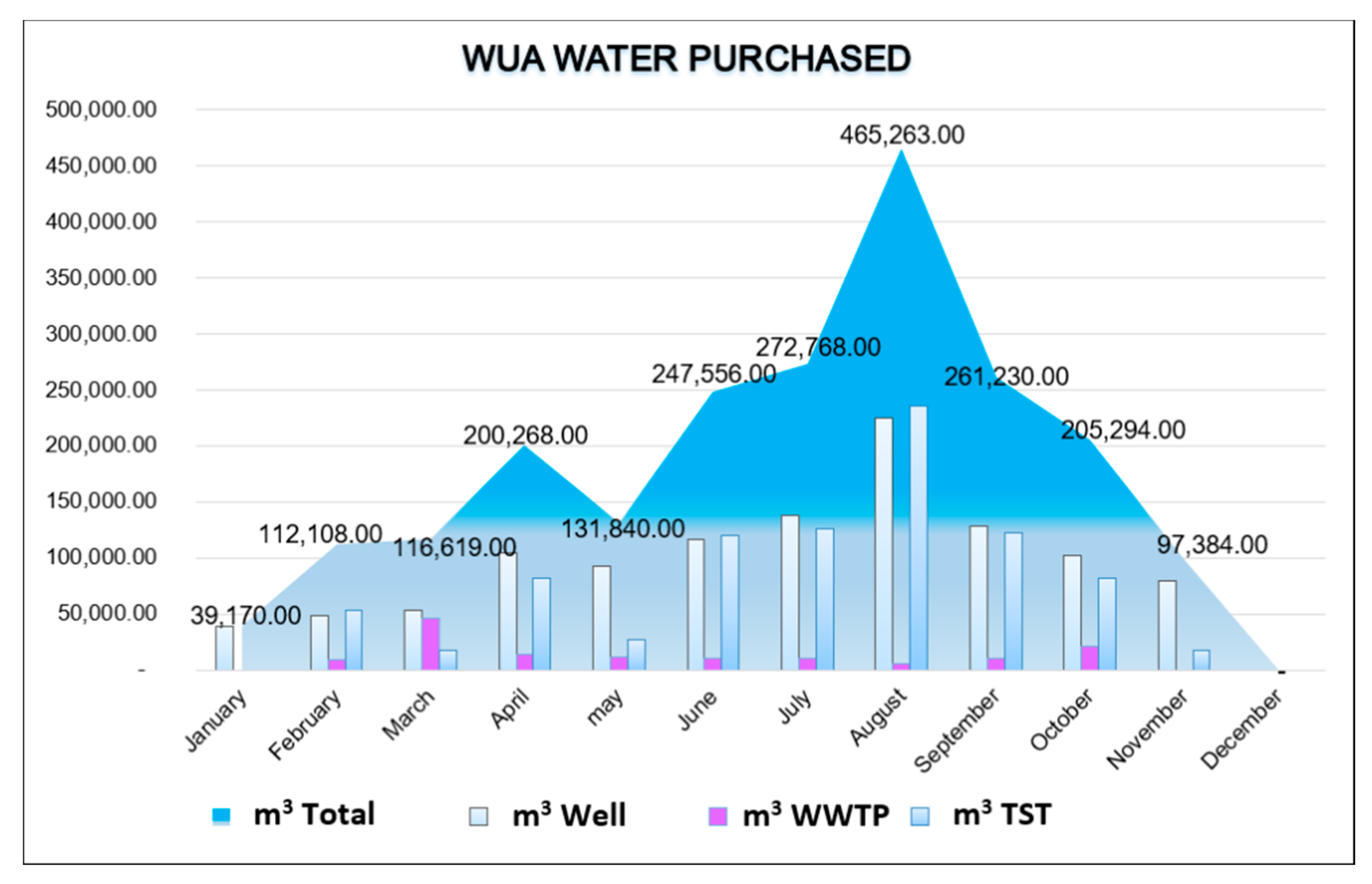
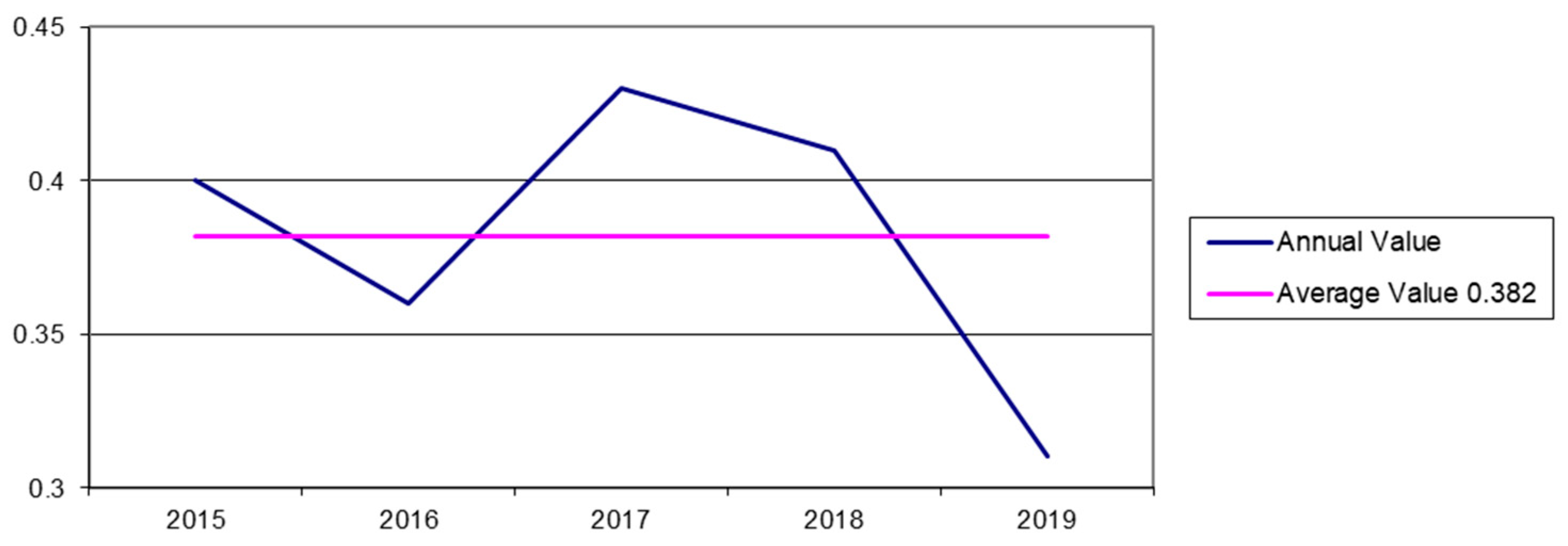
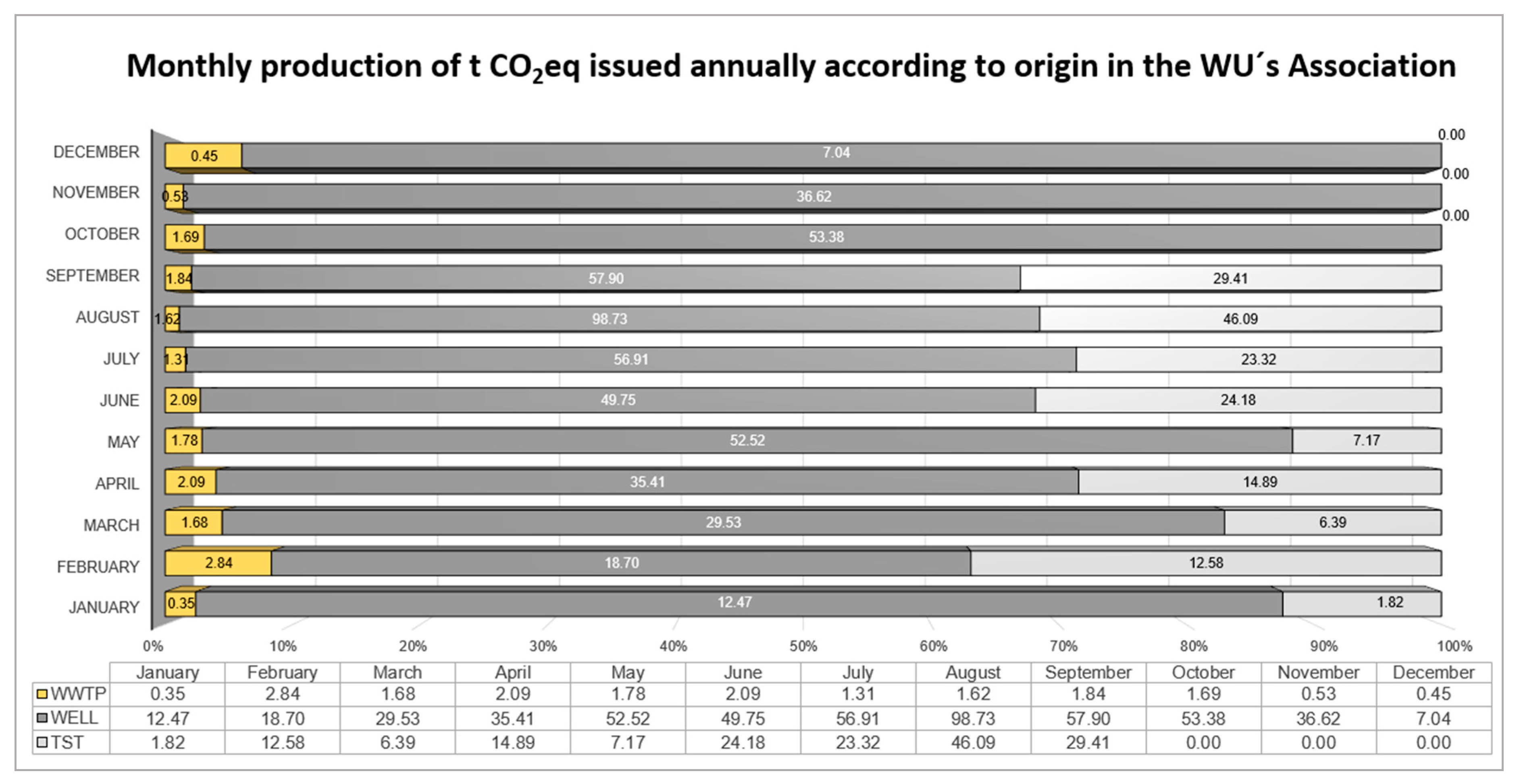
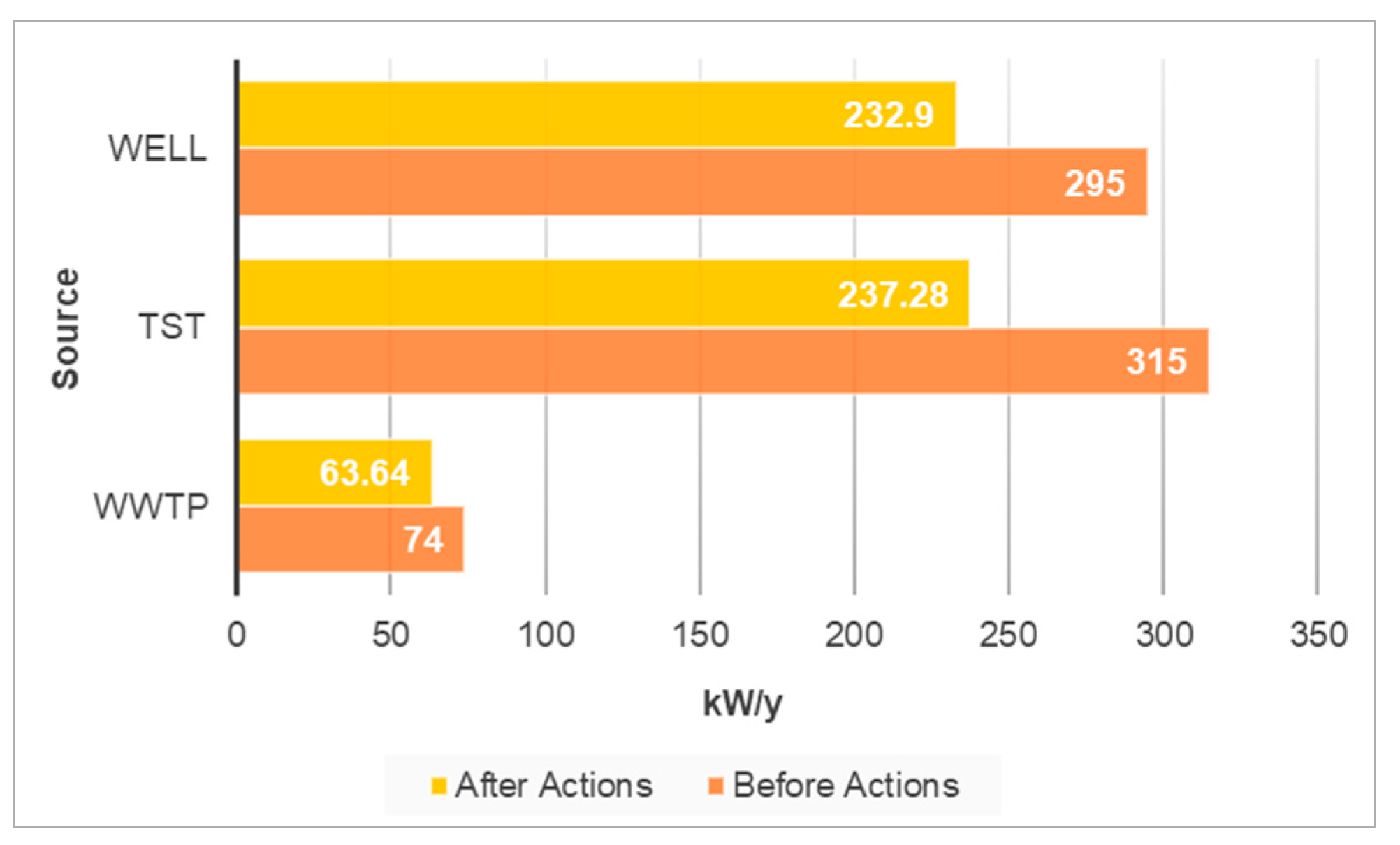

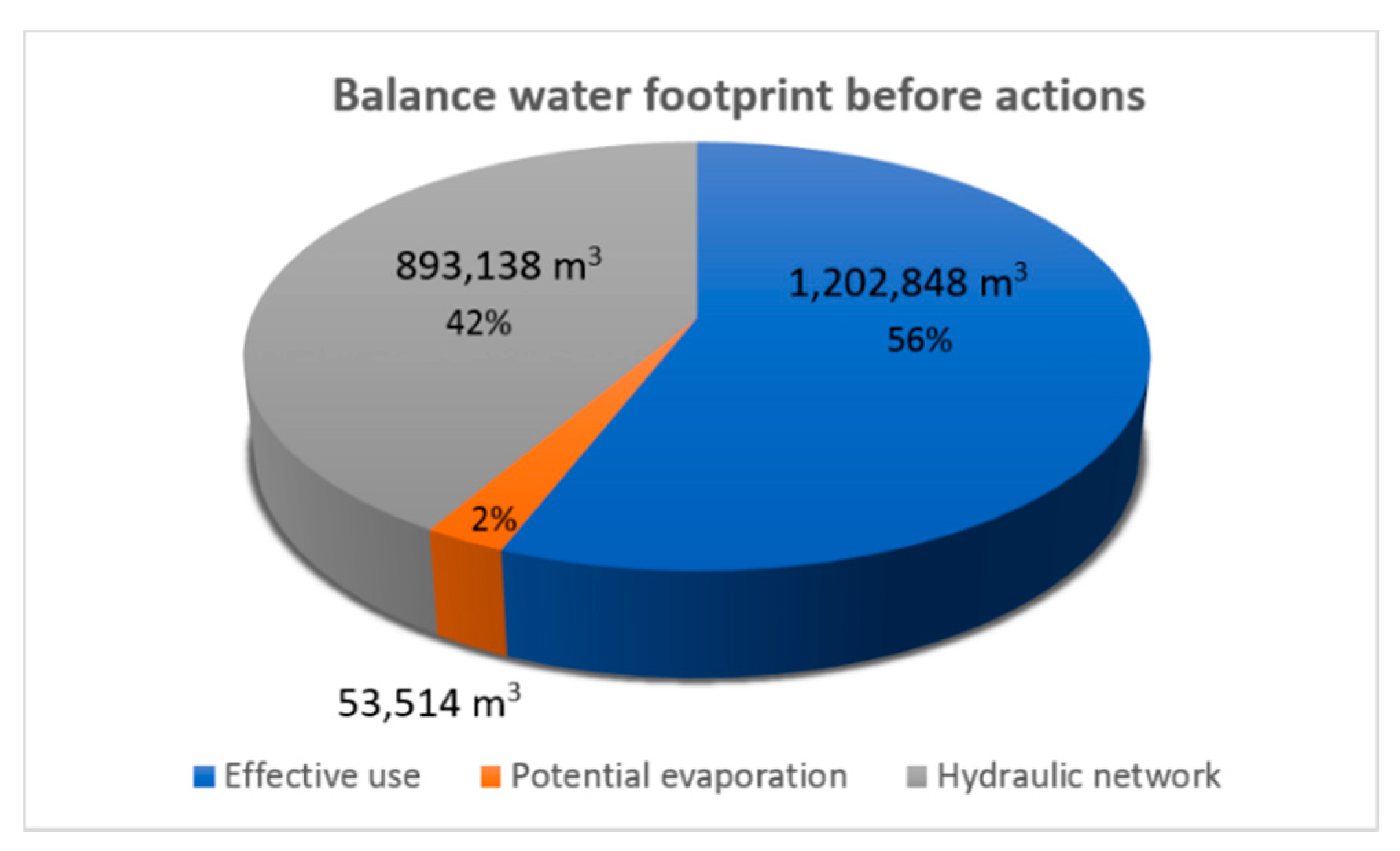
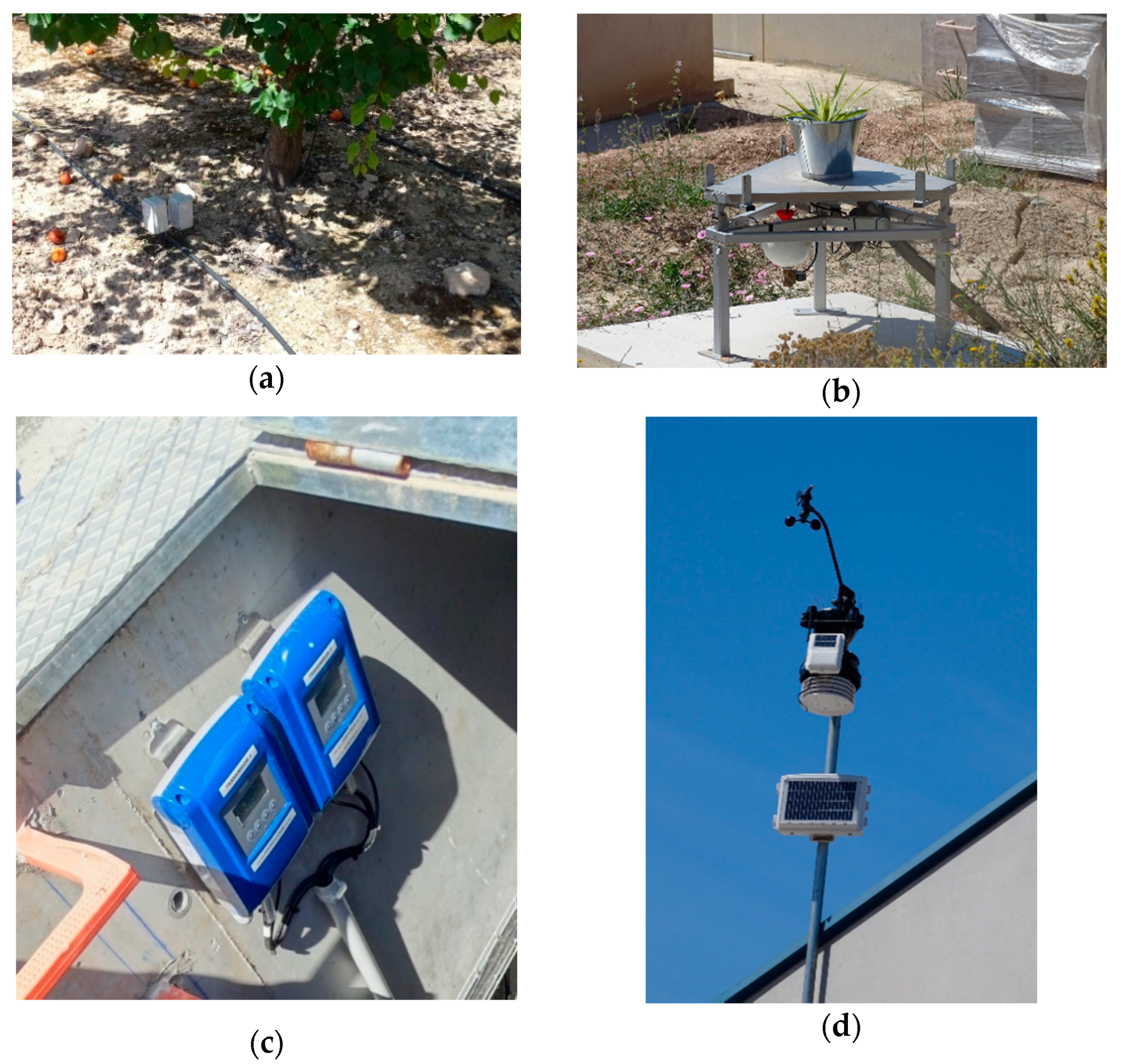

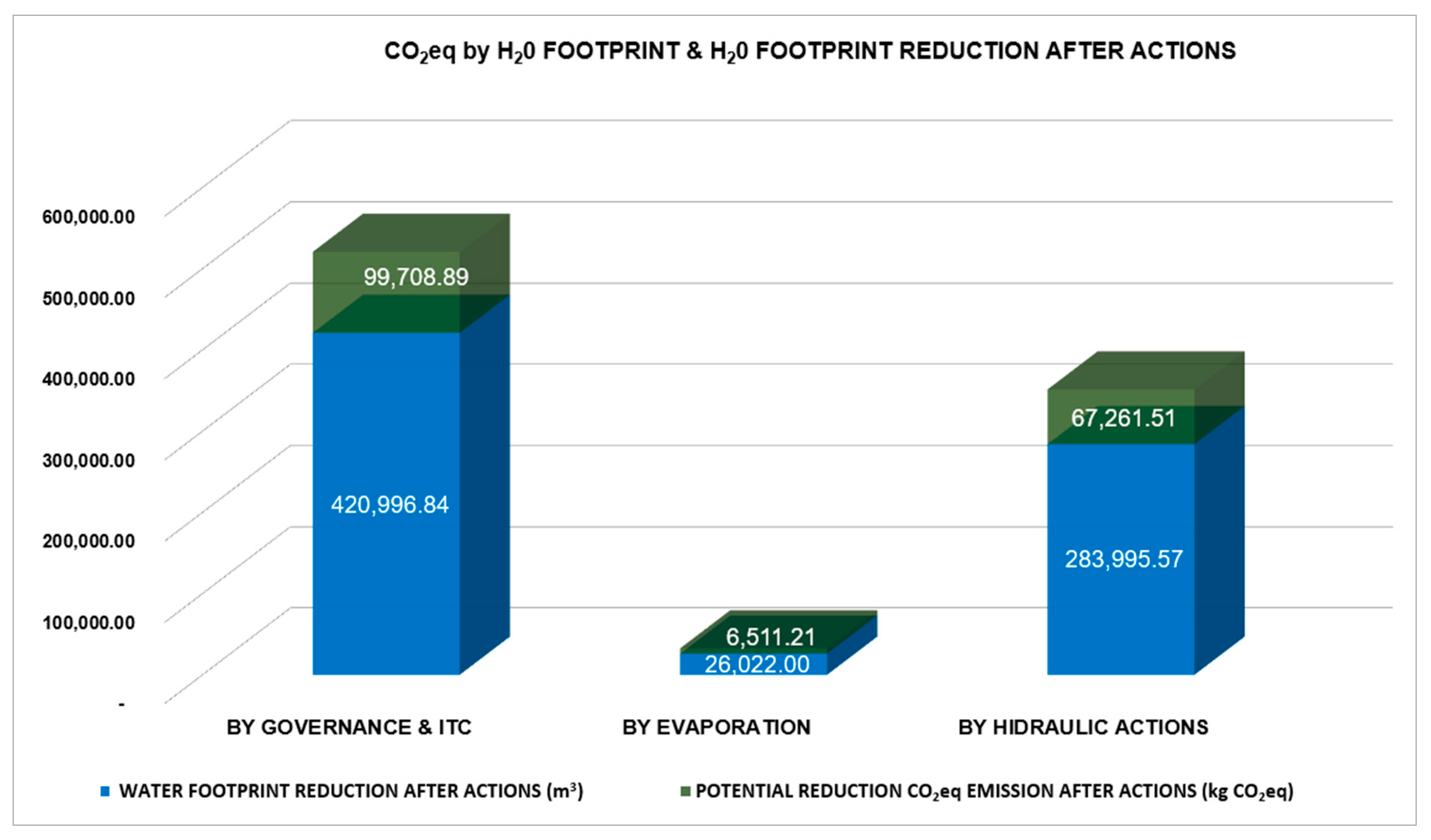
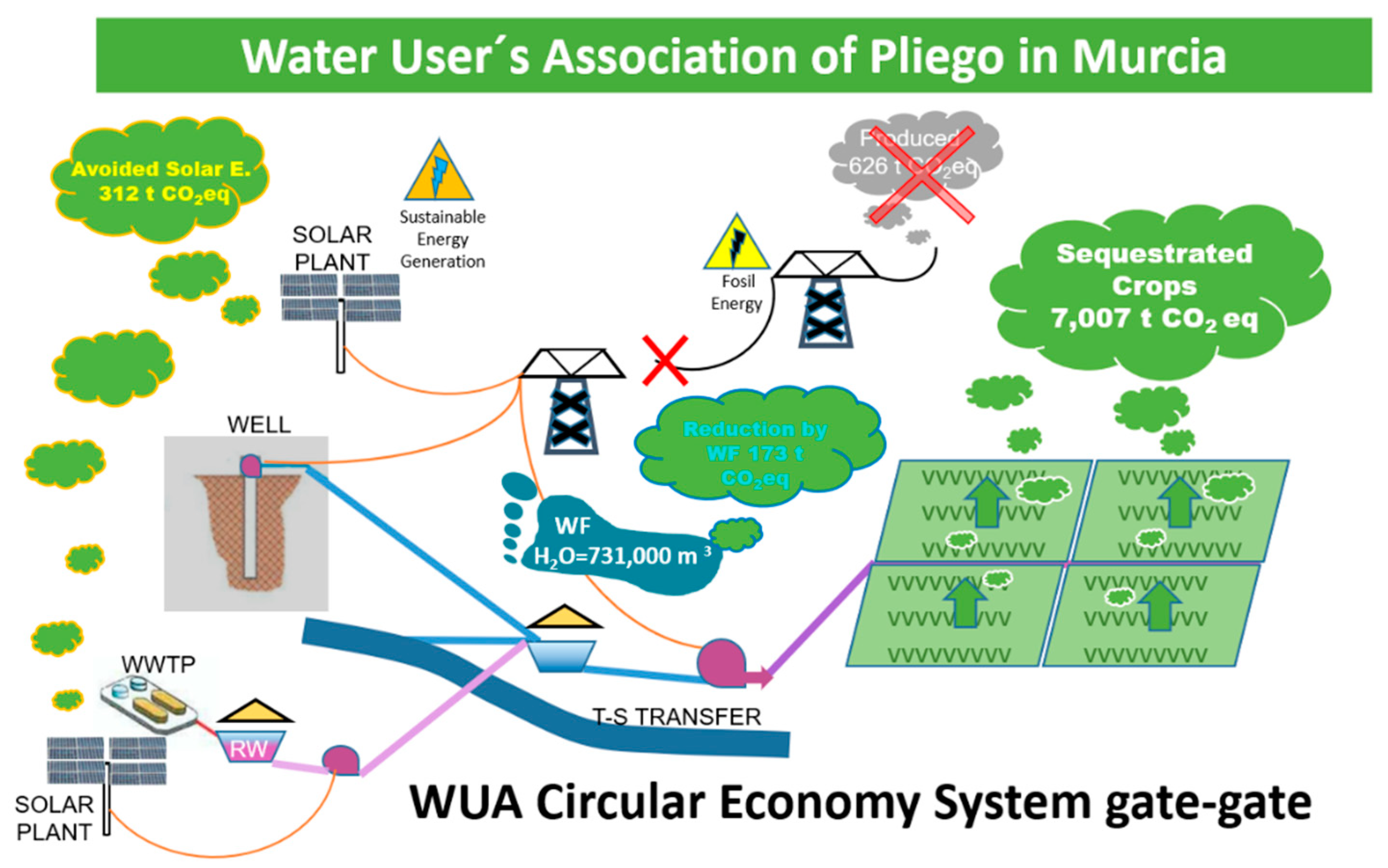
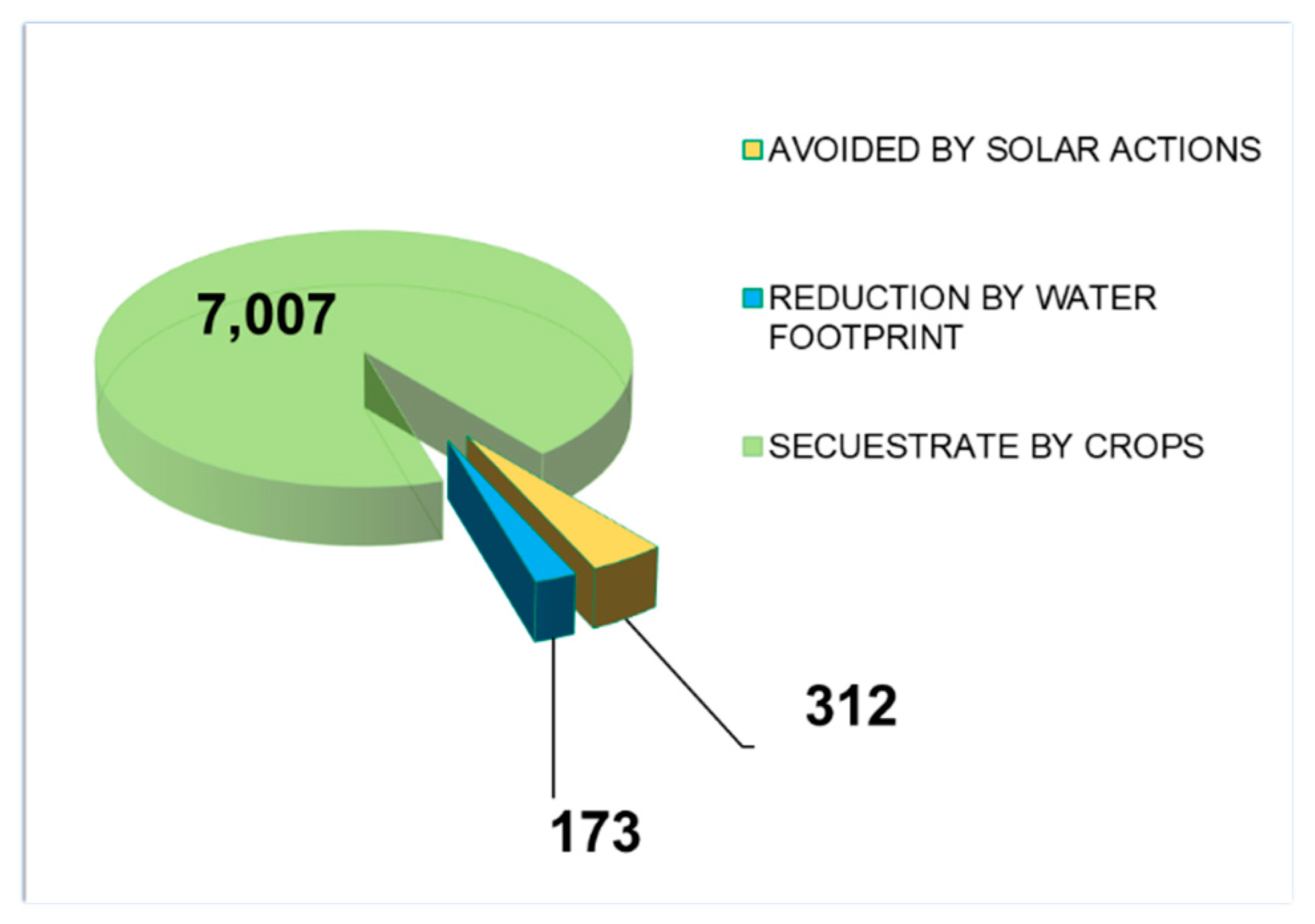
| Current Pump | Future Pump | |
|---|---|---|
| Power (kW) | Power (kW) | |
| Well | 295 | 232.9 |
| TST | 315 | 237.28 |
| WWTP | 74 | 63.64 |
| Photovoltaic Installation | Projected Power (kW) | Annual Generated Energy (kWh) | Units of 250 Wp, c/u |
|---|---|---|---|
| Pumping Well | 232.9 | 543,200 | 1400 |
| Pumping TST | 237.3 | 360,971 | 1400 |
| Pumping WWTP | 63.64 | 108,640 | 280,000 |
| Type of Irrigation System Value | % of Efficiency |
|---|---|
| Irrigation by surface with total coverage (blanket), with good management | 60 |
| Irrigation by surface with partial coverage (by furrows), with good management | 60–90 |
| Irrigation by sprinkling, with good management | 80 |
| Irrigation by dripping on the surface, with good management | 90 |
| Irrigation by underground drip, with good management | 95 |
| By Evaporation Reduction | ||||||||
|---|---|---|---|---|---|---|---|---|
| Surface (m2) | Volume (m3) | Manometric Eight (m.c.a.) | Before Actions (WeBA) | After Actions (WeAA) | ||||
| Annual Evaporation m3 (0.5 m3/m2) | Source | Annual Evaporation m3 | Source | Actions | ||||
| Raft 1 “Cota” San Quintin Well | 7534 | 45,000 | 440 | 3767 | Well | 75 | Well, TST, WWTP | |
| Raft 2 Anguilas Cherro 1 | 7667 | 24,000 | 415 | 3834 | Well, TST | - | Solar sector 1 | |
| Raft 3 Anguilas Cherro 2 | 6731 | 26,400 | 410 | 3366 | Well, TST | - | Solar Well | |
| Raft 4 Regulation Huerta Baja | 30,878 | 237,675 | 411 | 15,439 | Well, TST | 309 | Well, TST, WWTP | |
| Raft 5 Regulation Huerta Alta | 45,929 | 317,380 | 413.55 | 22,965 | Well, TST | 22,965 | Well, TST, WWTP | |
| Raft 6 La Esperanza | 5761 | 12,000 | 424 | - | - | Eliminated | ||
| Raft 7 WWTP Pliego | 8285 | 39,464 | 372 | 4143 | WWTP | 4143 | Well, TST | |
| Total Potential Water Evaporation | 53,514 | 27,492 | ||||||
| Origin of the Consumption | Water Footprint Reduction after Actions (m3) | |
|---|---|---|
| Direct consumption | By governance & ITC | 420,996.84 |
| Indirect consumption | By evaporation | 26,022.00 |
| By hydraulic actions | 283,995.57 | |
| Total | 731,014.41 m3 | |
| Cultivation | Surface (%) | Surface Area (ha) [44] | Annual Estimate Sequestrated kgCO2eq/ha | Annual Estimate of Emissions kgCO2eq/ha | Captured tCO2eq/y | Emission tCO2eq/y | Sequestrated tCO2 eq | ||
|---|---|---|---|---|---|---|---|---|---|
| Plant [45] | Field [47] | Plant [46] | Field [47] | ||||||
| Citric trees | 25 | 199.90 | 1696 | ||||||
| Lemon | 19 | 151.93 | 16,040 | 590 | 4812 | 520 | 2527 | 810 | 1717 |
| Orange half session | 2 | 15.99 | 9869 | 565 | 2961 | 515 | 167 | 56 | 111 |
| Orange total session | 4 | 31.98 | 6220 | 565 | 1866 | 515 | 217 | 76 | 141 |
| Fruit trees | 71 | 567.73 | - | 4940 | |||||
| Apricot tree | 16 | 127.94 | 8450 | 825 | 2535 | 740 | 1187 | 419 | 768 |
| Peach tree | 37 | 295.86 | 14,463 | 835 | 4339 | 740 | 4526 | 1503 | 3023 |
| Almond tree | 18 | 143.93 | 11,356 | 475 | 3407 | 445 | 1703 | 554 | 1149 |
| Vegetables | 4 | 31.98 | - | 98 | |||||
| Lettuces and similar | 4 | 31.98 | 4225 | 830 | 1268 | 735 | 162 | 64 | 98 |
| Total | 100 | 799.61 | 7007 | ||||||
| Authors | Country | Source Energy Supply | Irrigation Type | Water Source | GHG Emissions |
|---|---|---|---|---|---|
| [49] | Pakistán | Electricity-Diesel | Underground | 0.732 kgCO2eq/L | |
| 0.062 kgCO2eq/kWh | |||||
| [33] | Spain | Electricity | Located | Surface | 0.166 kgCO2eq/kWh |
| [48] | China | Electricity | Underground | 0.341 kgCO2eq/kWh |
Publisher’s Note: MDPI stays neutral with regard to jurisdictional claims in published maps and institutional affiliations. |
© 2020 by the authors. Licensee MDPI, Basel, Switzerland. This article is an open access article distributed under the terms and conditions of the Creative Commons Attribution (CC BY) license (http://creativecommons.org/licenses/by/4.0/).
Share and Cite
Chazarra-Zapata, J.; Parras-Burgos, D.; Pérez-de-la-Cruz, F.-J.; Ruíz-Canales, A.; Molina-Martínez, J.M. Reducing the Carbon Footprint of the Water-Energy Binomial through Governance and ICT. A Case Study. Water 2020, 12, 3187. https://doi.org/10.3390/w12113187
Chazarra-Zapata J, Parras-Burgos D, Pérez-de-la-Cruz F-J, Ruíz-Canales A, Molina-Martínez JM. Reducing the Carbon Footprint of the Water-Energy Binomial through Governance and ICT. A Case Study. Water. 2020; 12(11):3187. https://doi.org/10.3390/w12113187
Chicago/Turabian StyleChazarra-Zapata, Jesús, Dolores Parras-Burgos, Francisco-Javier Pérez-de-la-Cruz, Antonio Ruíz-Canales, and José Miguel Molina-Martínez. 2020. "Reducing the Carbon Footprint of the Water-Energy Binomial through Governance and ICT. A Case Study" Water 12, no. 11: 3187. https://doi.org/10.3390/w12113187
APA StyleChazarra-Zapata, J., Parras-Burgos, D., Pérez-de-la-Cruz, F.-J., Ruíz-Canales, A., & Molina-Martínez, J. M. (2020). Reducing the Carbon Footprint of the Water-Energy Binomial through Governance and ICT. A Case Study. Water, 12(11), 3187. https://doi.org/10.3390/w12113187









